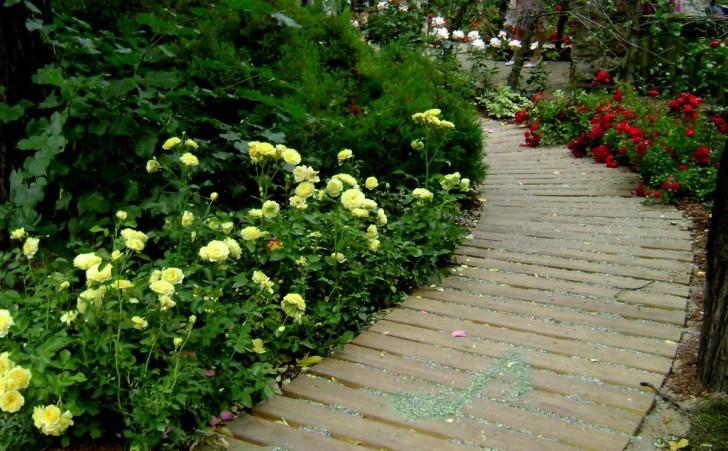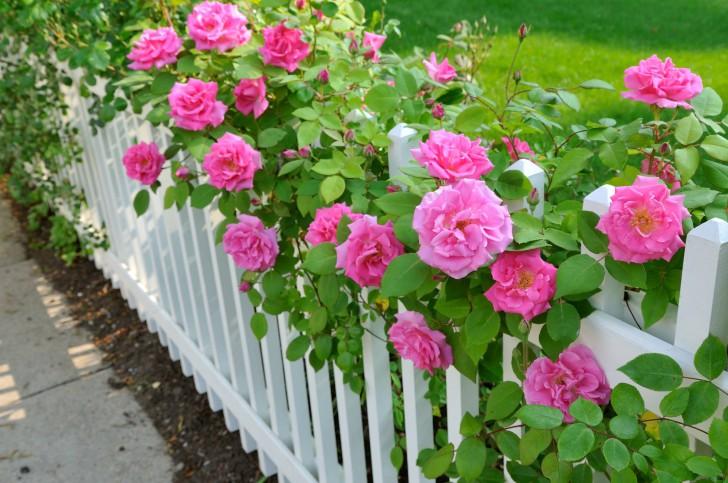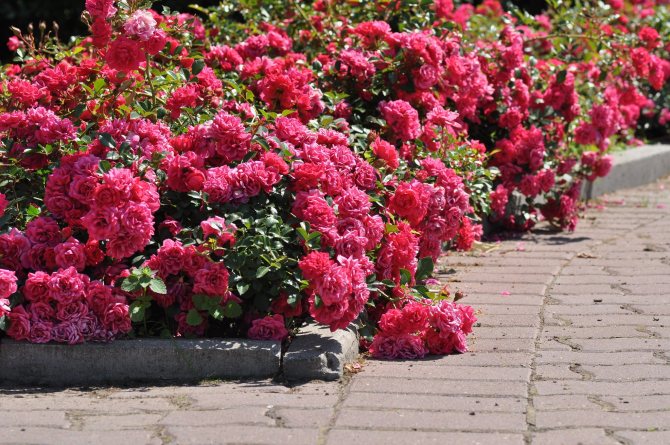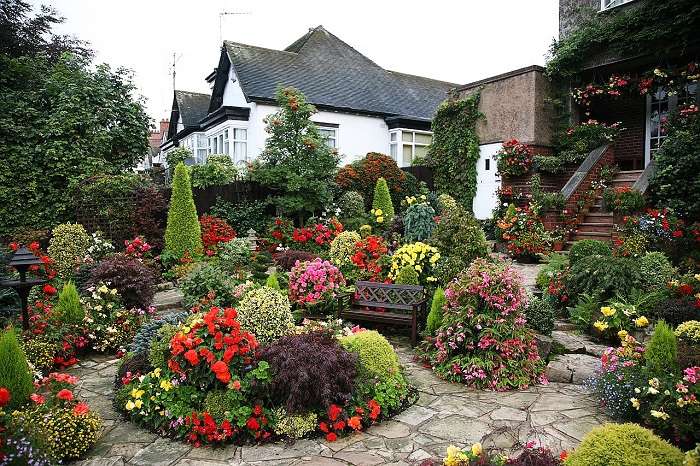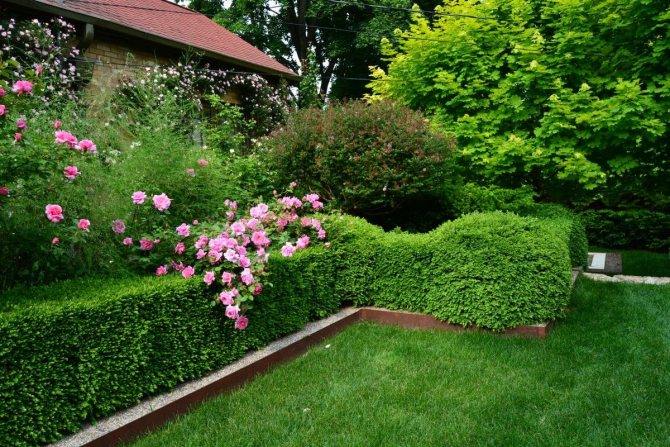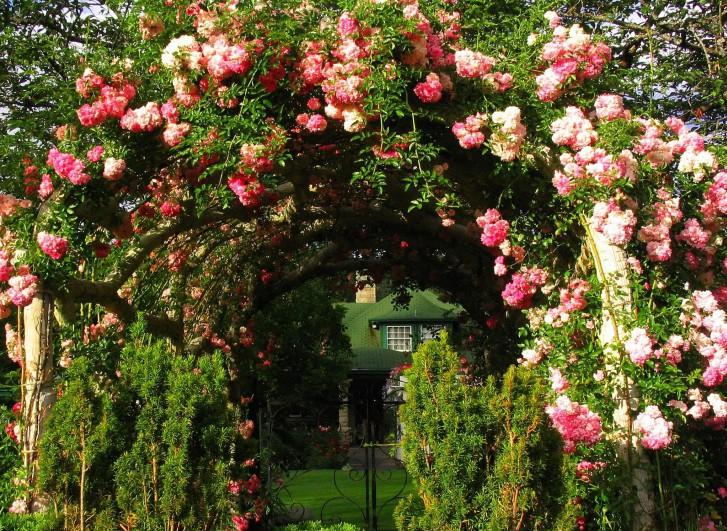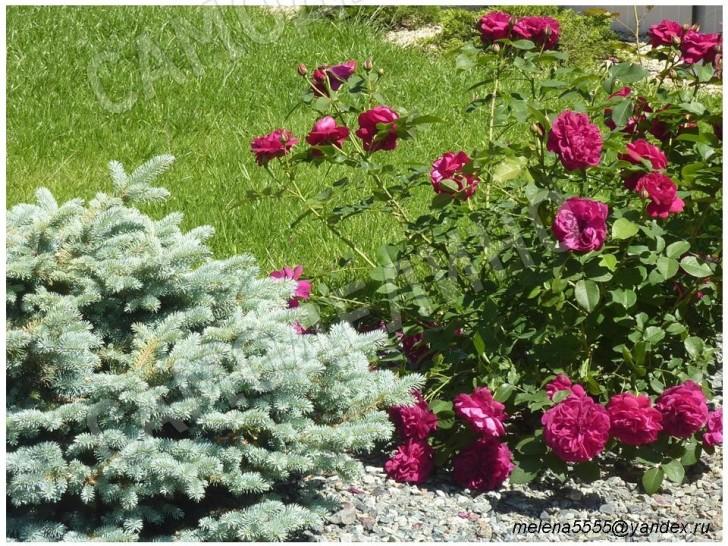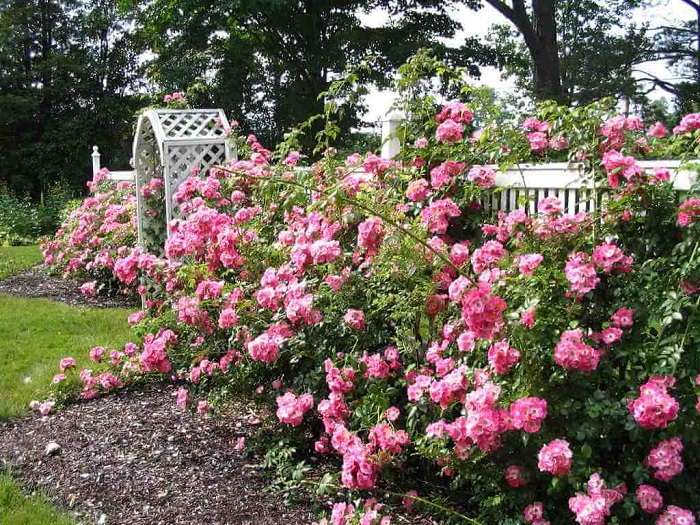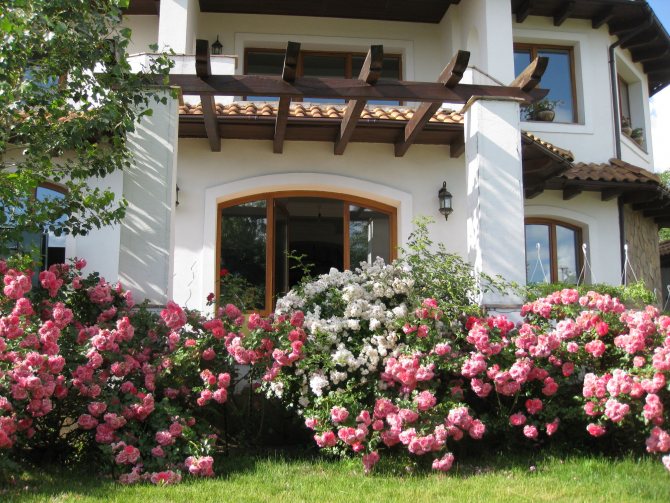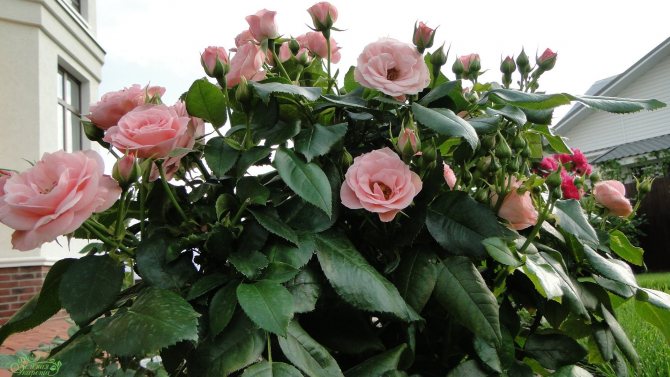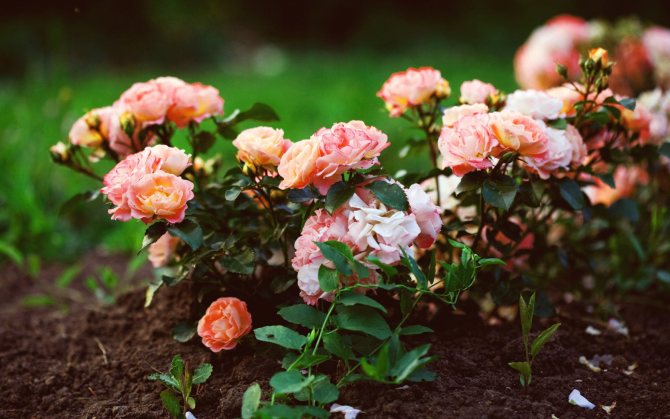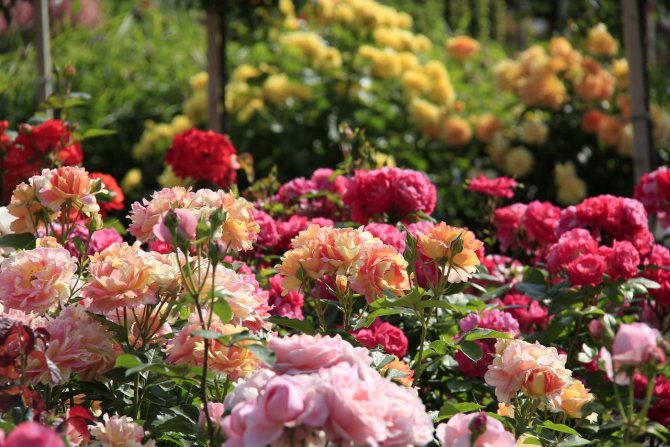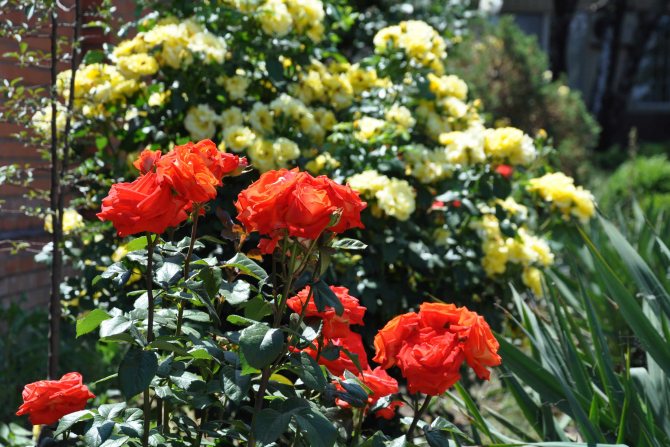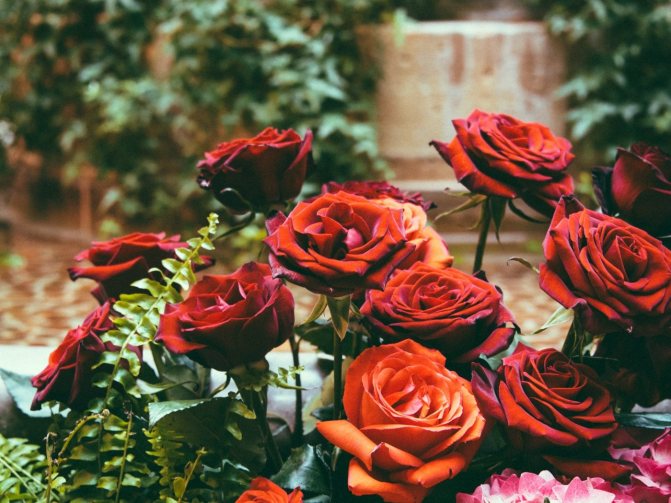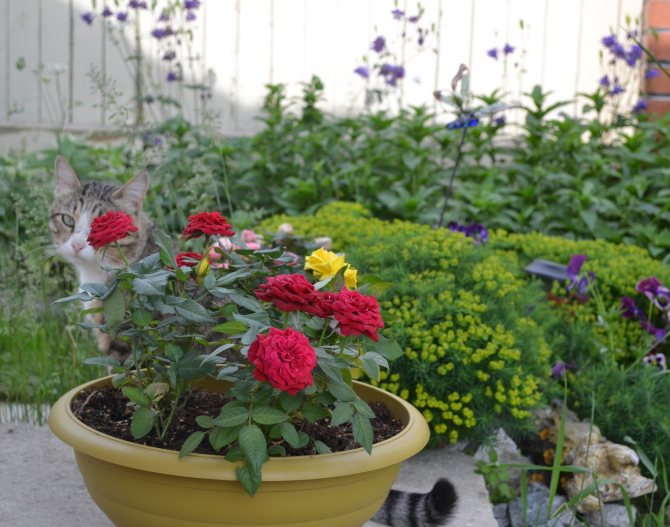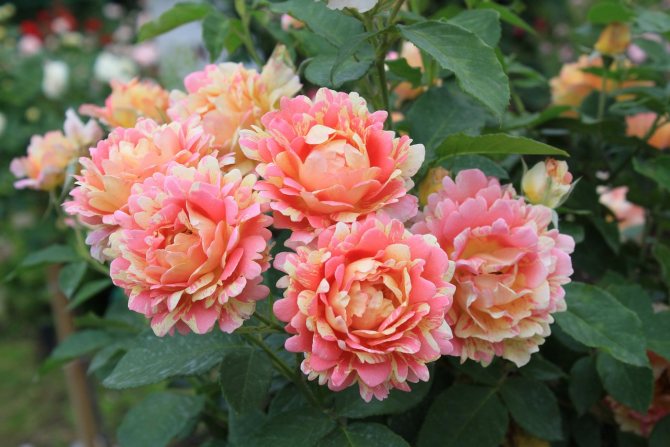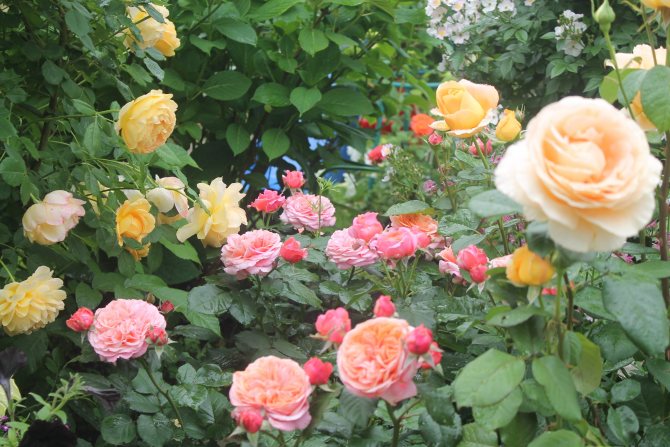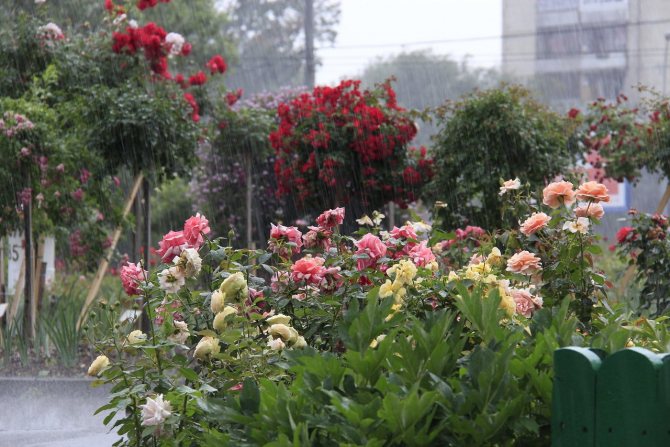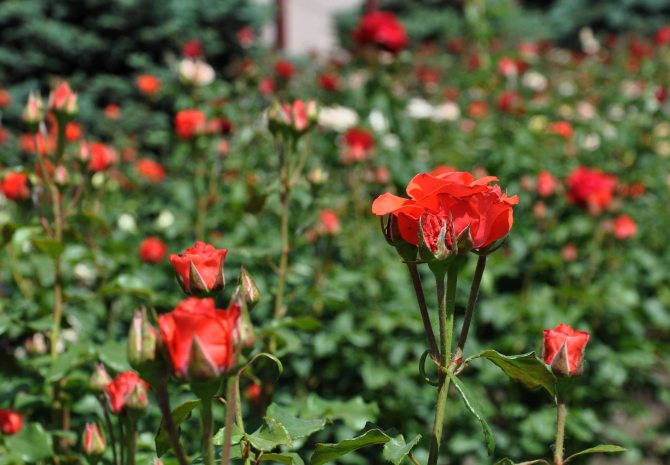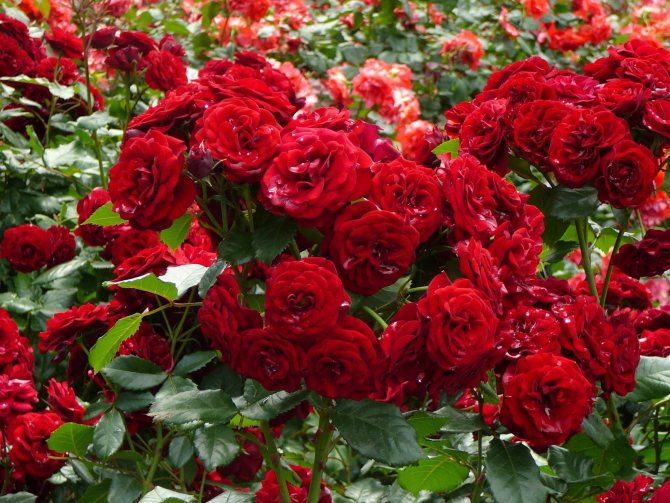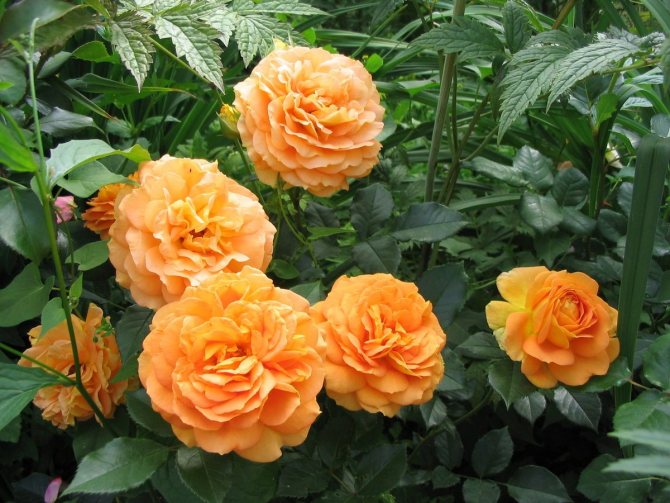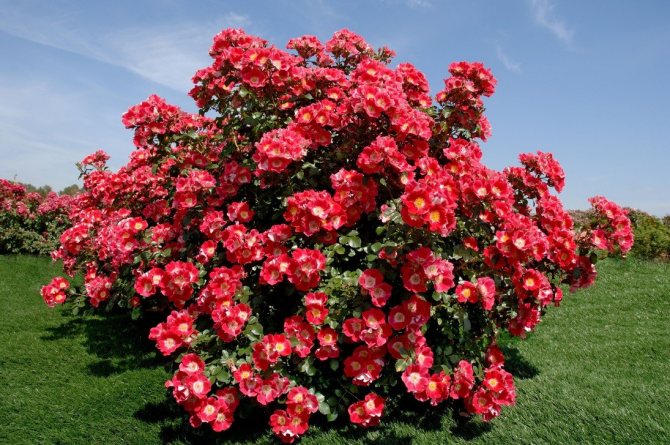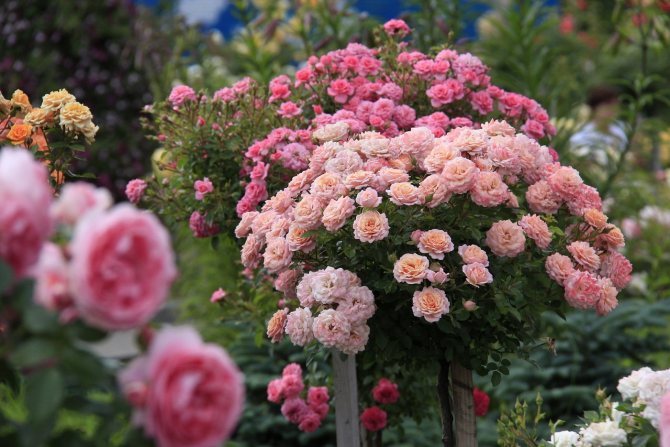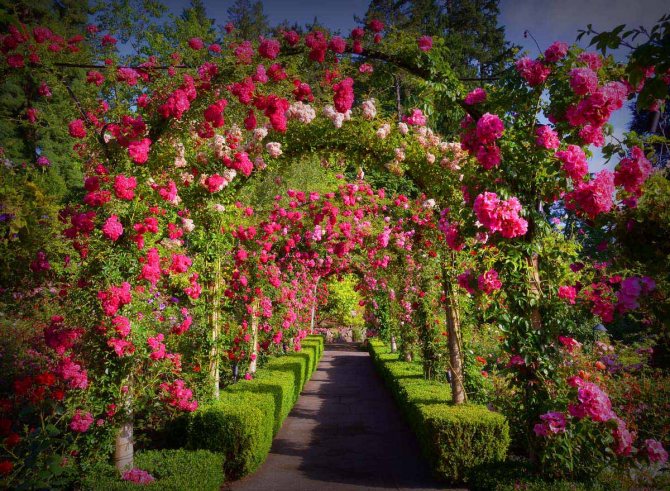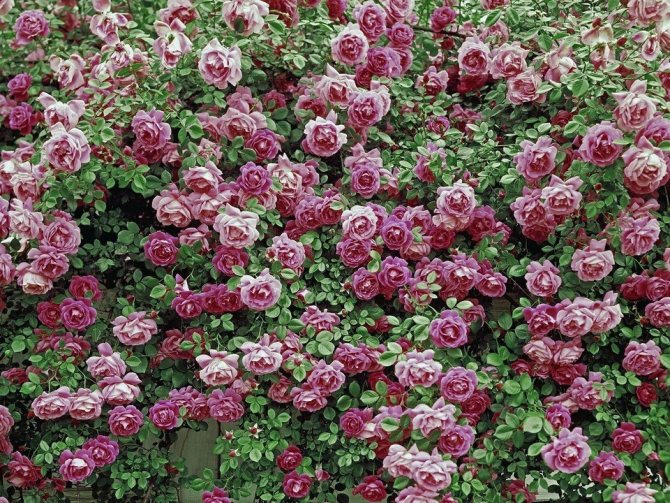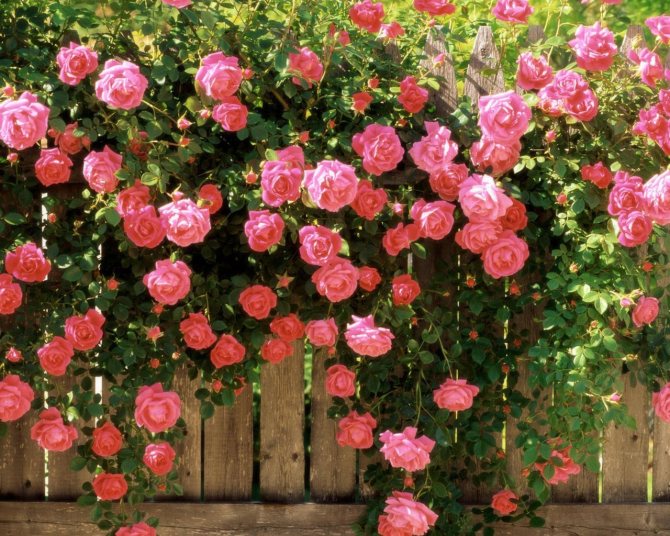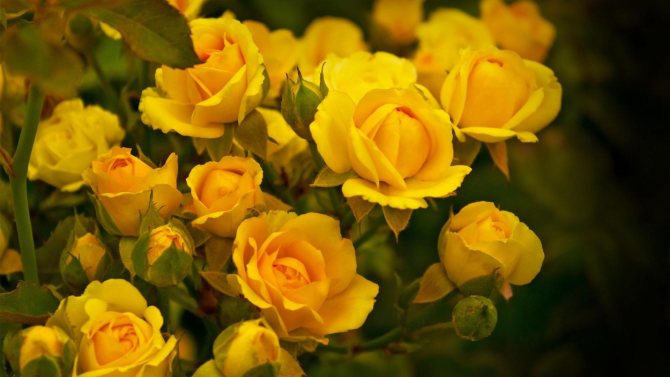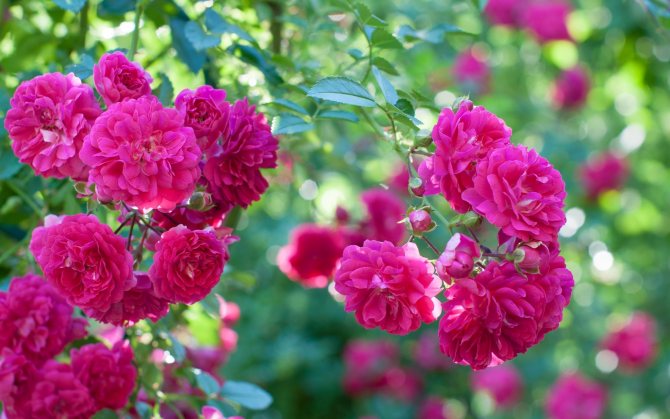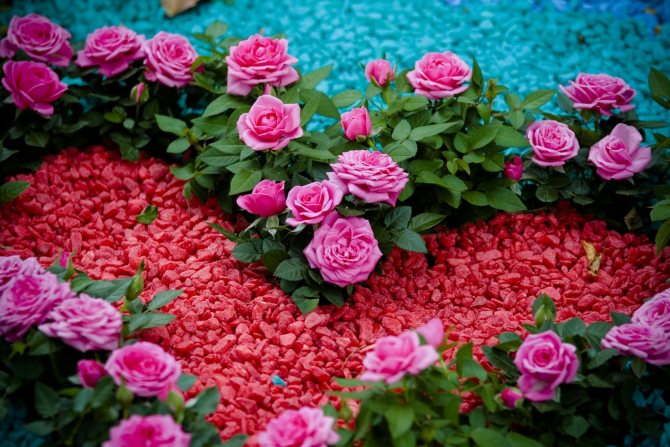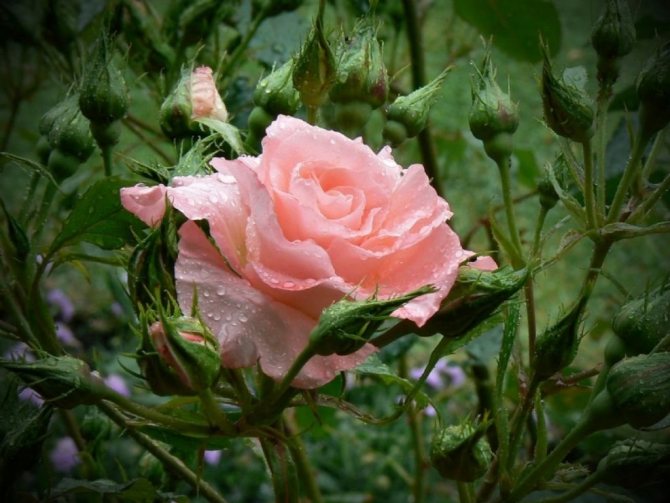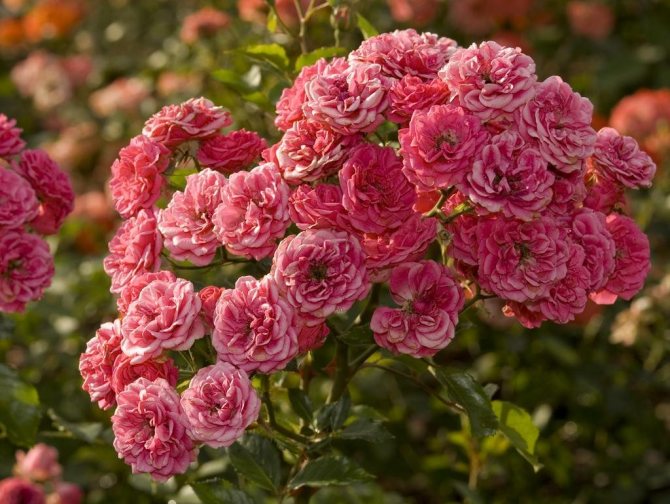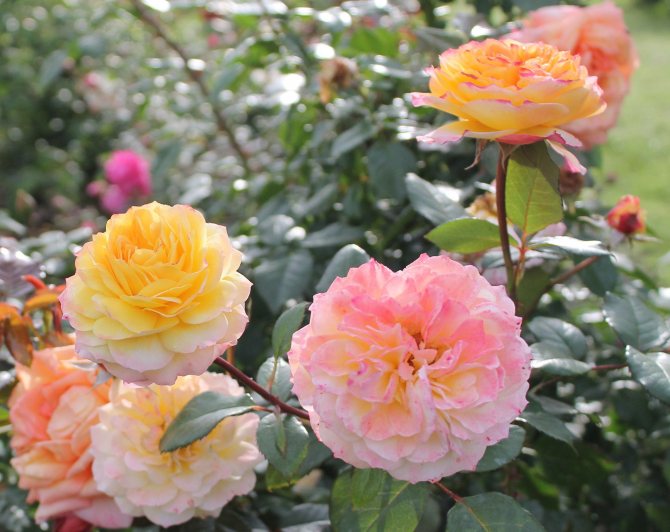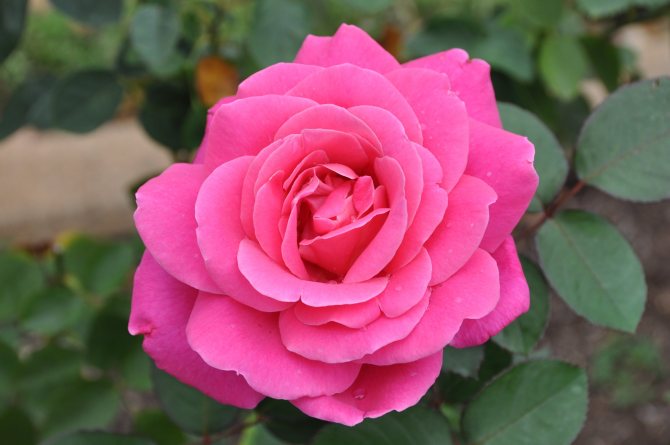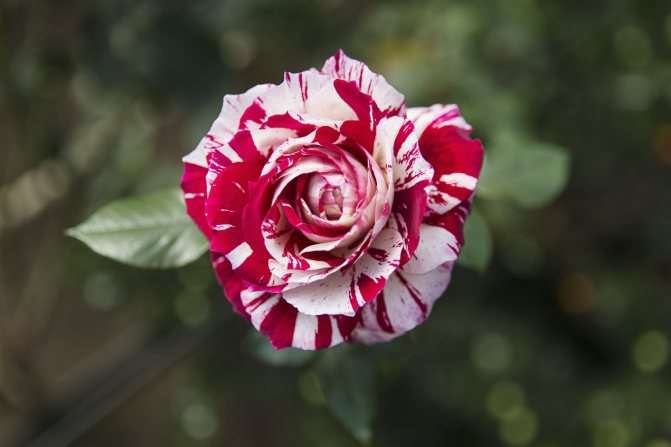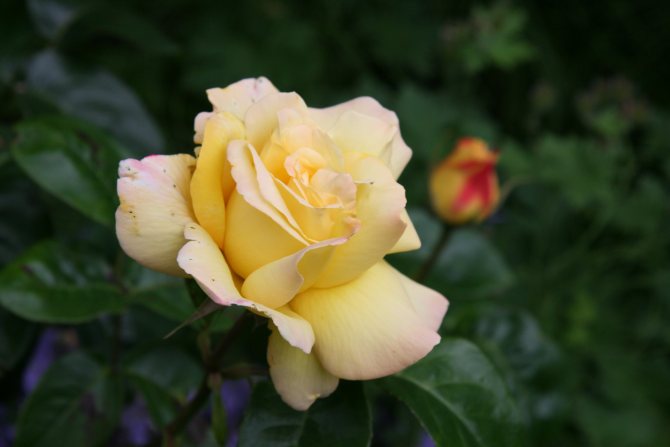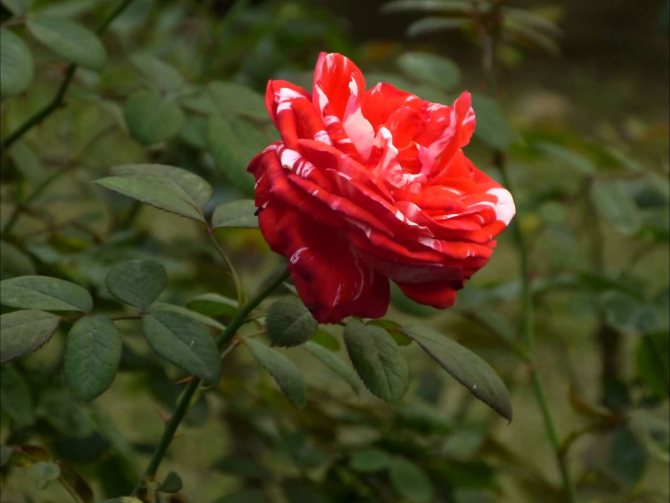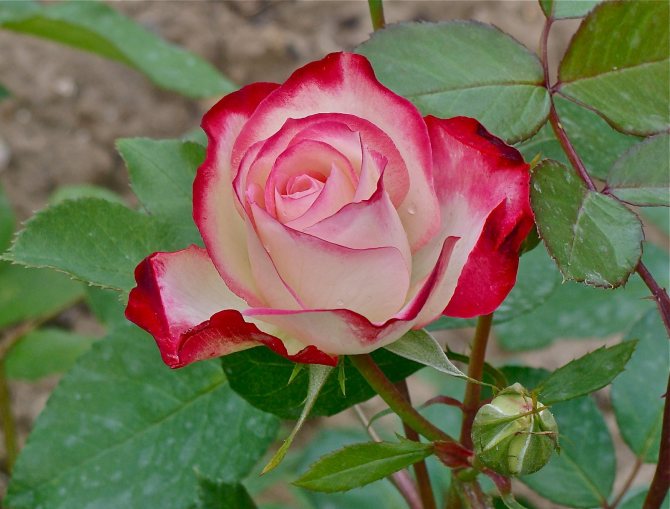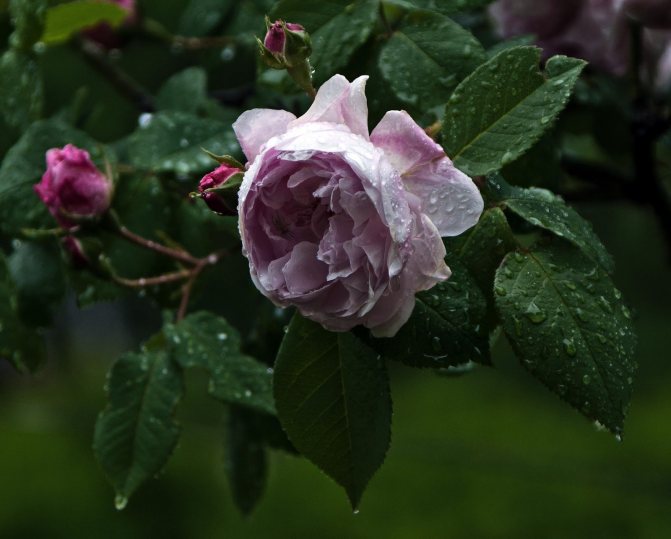For years, many summer residents have dreamed of growing roses on their site, but they put this question on the back burner, considering such flowers to be quite capricious. In fact, everyone can do the work, you just need to know the rules for planting roses and the basic techniques for caring for them. We will tell you how to choose a site for a rose garden, which plants to choose for your garden and how to plant seedlings without mistakes in a place prepared for a flower garden.
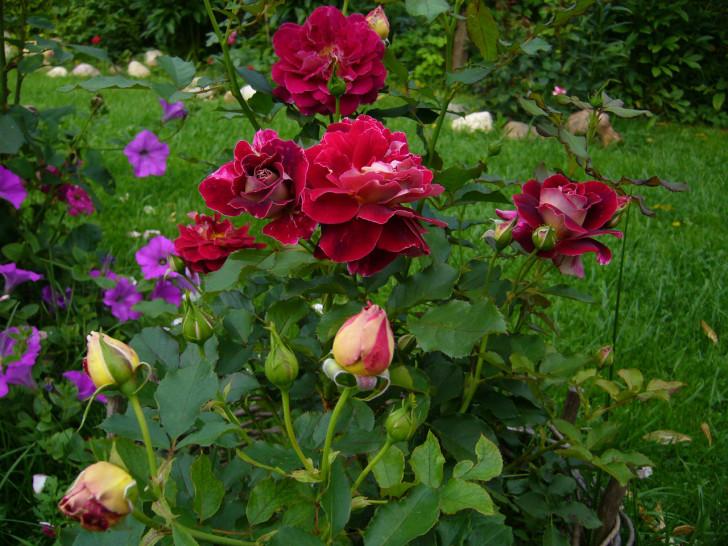
Varieties of rosaries
Any piece of land on which roses are purposefully and predominantly grown can be called a rose garden, no matter how many rose bushes it contains. It can include several plants of the same species or several dozen different varieties, occupy a small corner in the yard or a large area of the site.
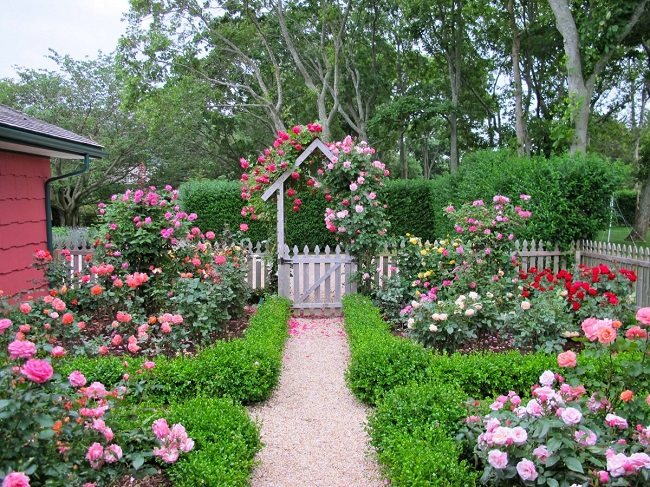

In terms of the style of performance, a rose garden of regular planning (parterre) and a landscape one stand out. The parterre rose garden has the correct geometric proportions, the plants are planted in it in symmetrical rows or stripes.
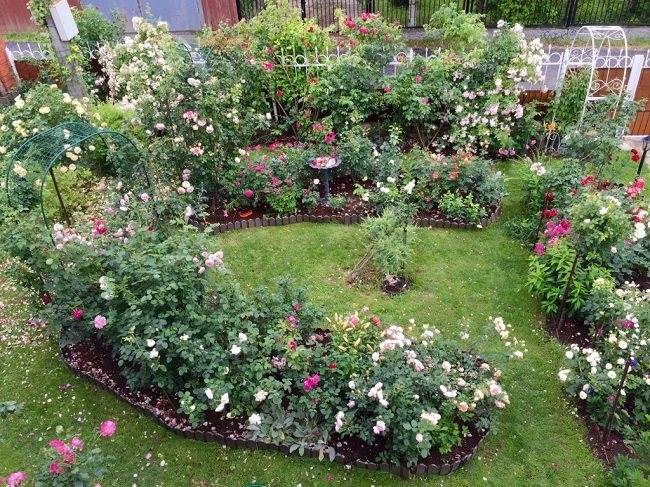

Paving is arranged in the aisles or a lawn is sown. A regular rose garden includes one or more flower beds, depending on the area allocated for it. In order not to introduce dissonance into the flower garden, roses of 2-3 shades are used in each flower bed.
Important reminder. In the parterre rose garden, planting roses are combined with conifers and plants that have a not bright, but beautiful shade of foliage: seaside cineraria, gray fescue, narrow-leaved lavender. Landscapers do not recommend planting bright-flowering plants in a regular rose garden.
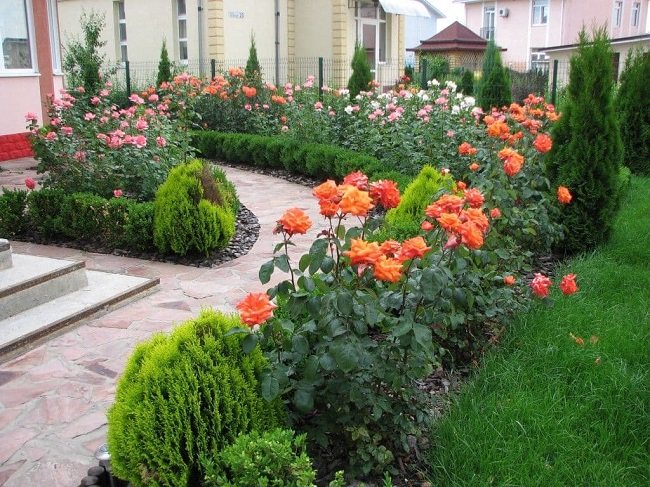

In a small area, a landscape flower garden looks better. It can include as many types of roses with a variety of varieties and shades as the space allocated for it and the design idea allows. In addition to the main content, it is allowed to include other flowering plants, both annuals and perennials, in the landscape.
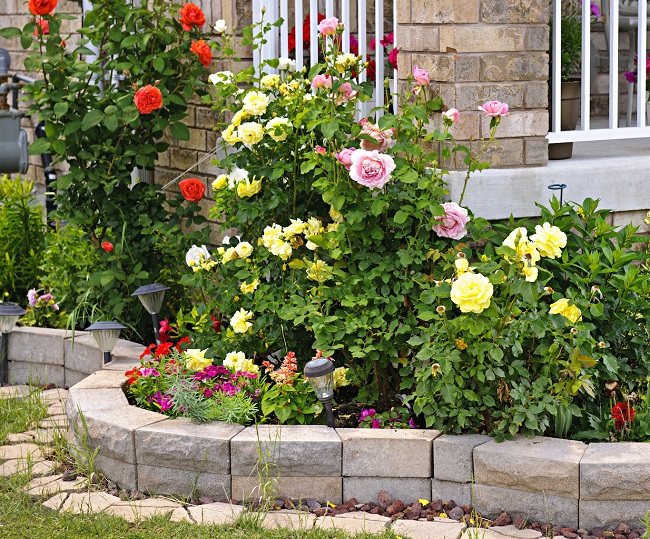

A place
There are two things to keep in mind when choosing a location. Firstly, it makes no sense to create a beautiful flower garden, in the device of which expensive planting material is used, in a remote corner of the garden. Therefore, an area open for review is allocated for the rose garden. As a rule, this is a front garden, flower beds on the territory of the front yard, a resting place - that is, that part of the estate where it will be most convenient to admire the flowers.
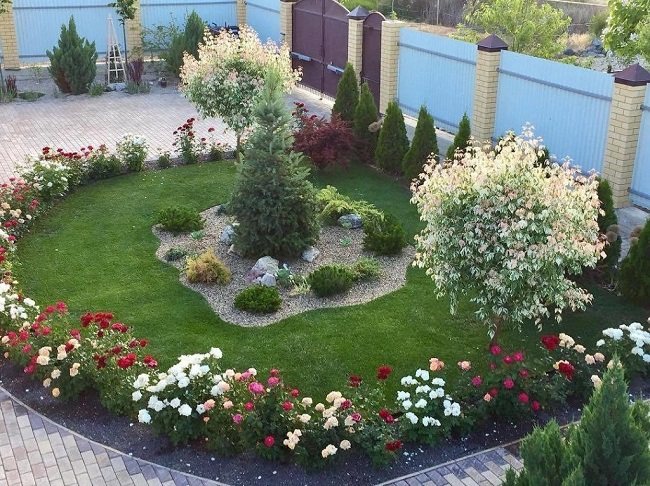

Secondly, you need to take into account the needs of the plants themselves. Roses will feel comfortable in a sunny, wind-protected place.
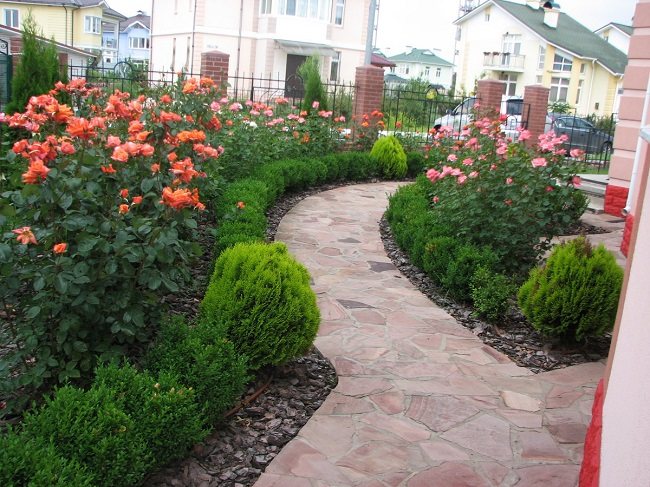

It is not recommended to break a flower garden under the crowns of tall trees, as well as from the north or west side near the house. Only a few of David Austin's English rose varieties prefer sparse shade. In the hot sun, they literally droop and represent a pitiful sight.
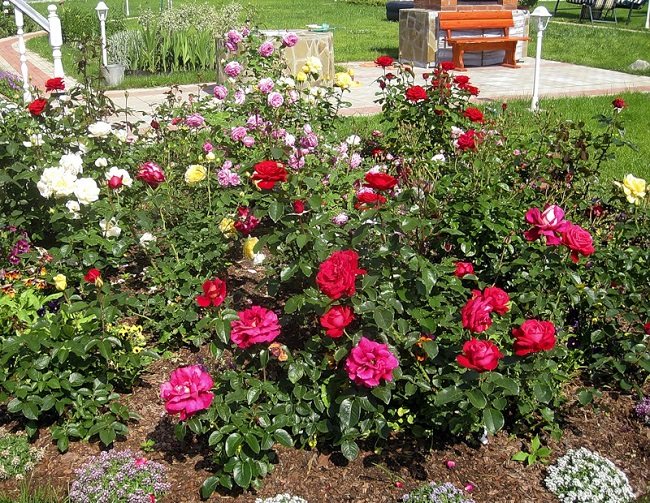

On the site for the rose garden, there should be fertile, moisture-permeable soil. Heavy rocky or clayey boggy land of low-lying areas will not work, as well as poor sandy.
Advice. If the soil is sparse, although the space is otherwise suitable, the soil can be improved or the top layer replaced entirely.
The use of climbing roses in the landscape
This variety of roses beautifully complements pergolas, arches, fences and gazebos. Their presence lies not only in decorative qualities.During the flowering period, green lashes can hide unfinished walls, fences, structures.
Decoration options:
- A tandem of climbing roses and a snow-white picket fence is an ideal solution for dividing the site into functional zones.
- Vertical braiding of the facade of the house. In this case, the style does not matter. Buds look harmoniously on natural stone masonry.
- Framing gates that lead to a shady garden.
- Framing arches over garden paths. For this, metal structures are suitable - they are practical and are well decorated with green lashes.
- Decoration of wood stands, trellises, trellises.
Advice! To cover vertical planes with roses, you can use trellis made of wire threads in a plastic braid. They are mounted on a wall or a blank fence so that the whips have a support.
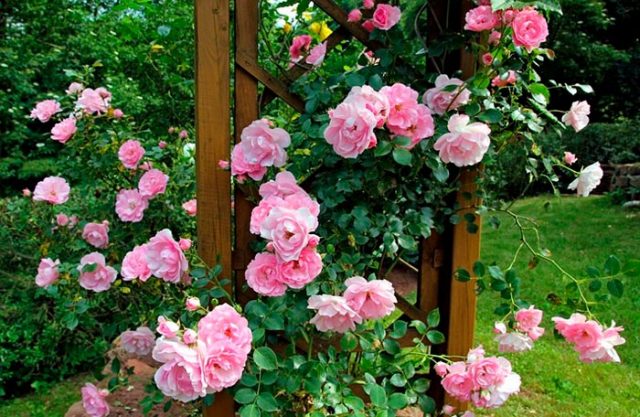

Climbing roses
Drawing up a diagram
When laying out a regular flower garden with roses, rectilinear forms are used. To provide a good overview of each plant, two planting schemes are used: Taller species of roses are planted along the center line, and miniature species at the edge, or in a checkerboard pattern.
In a landscape rose garden, it is important to think over the color of the flower garden. A very successful combination of white and cream roses, diluted with the light lilac color of lavender.
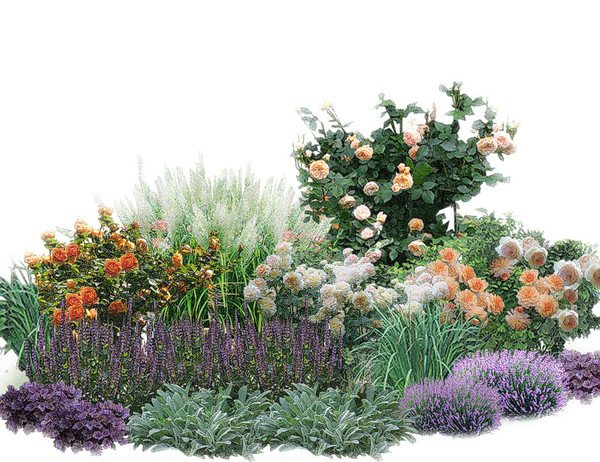

Also, the white scale looks great on the greenery of conifers. Tui can form a background for a rose garden, and creeping juniper forms are placed in the foreground, creating a kind of foot in the rose bushes.
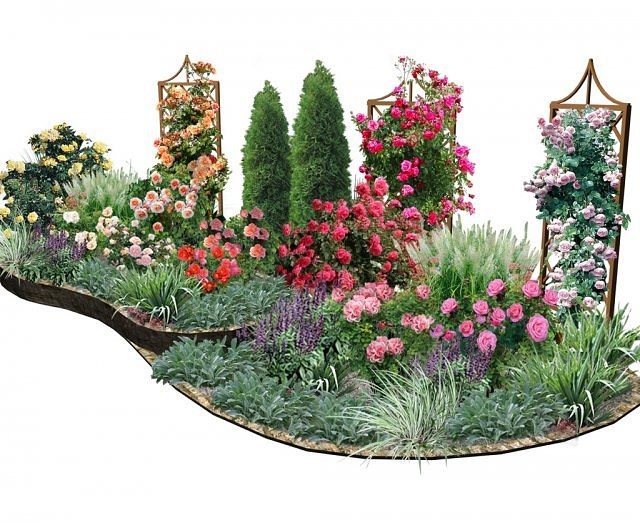

A very interesting rose garden, conceived in the form of a mixborder. Its advantage is that you can put together different types of roses: climbing, straba, creeping. They are placed in ascending order and are diluted with perennials with decorative foliage.
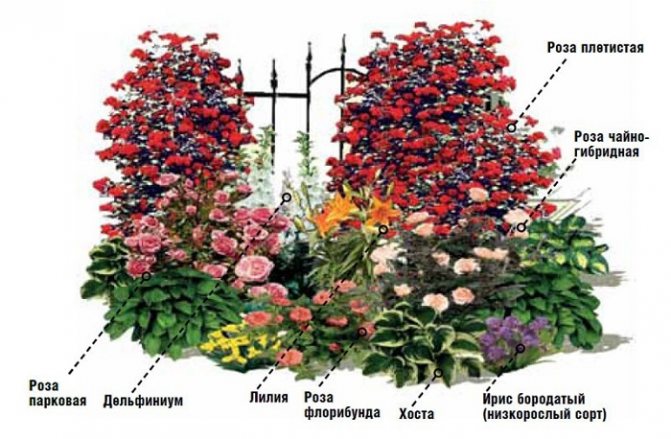

Practical advice. For the convenience of caring for the rose garden, plants are planted in it in separate groups of several bushes. The space between such "blocks" is filled with grasses, paving, lawn.
Arch with climbing roses
The arched support for the design requires special attention. Curly varieties are also best suited for her.
It is best to choose one variety of roses for each support. And the bushes need to be planted close to each other and always form a planting.
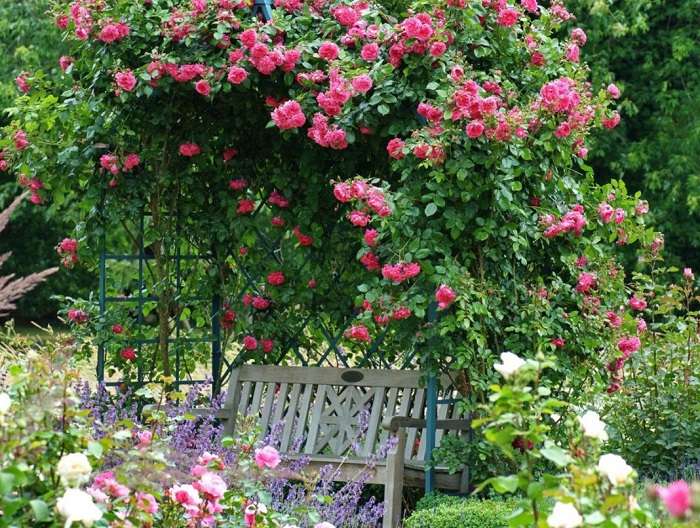

This design is made in the form of a gazebo. For example, you can put 4 arches side by side, create a composition, and put benches or tables under them. This arrangement will be a very cozy addition to your garden.
What roses to plant
When choosing seedlings, several nuances should be taken into account: where they will be planted, whether the owners will be able to take care of them regularly, and how many bushes can be placed in the flower garden. The questions are not idle, since it depends on them which roses are best for the rose garden.
If the plants are intended for an arch, trellis, or porch decoration, climbing roses should be planted. They are used to create a background for other plants, as a screen near a resting place or as a decoration on the facade of a residential building.
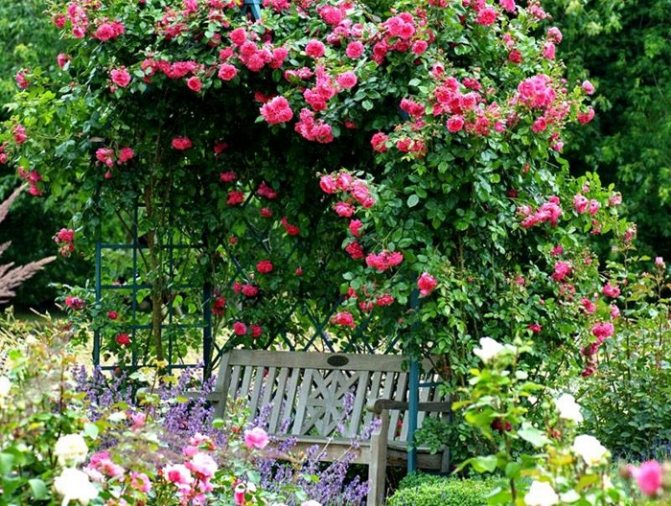

Climbing roses on the gazebo
In a rarely visited cottage, it is better to use roses that are not capricious, resistant to diseases and do not need winter shelter. This is due to the fact that during infrequent arrivals, the owners do not always manage to pay attention to the dacha beauties. Hardy varieties of park and landscape roses, which are distinguished by long flowering and a variety of colors, are suitable.
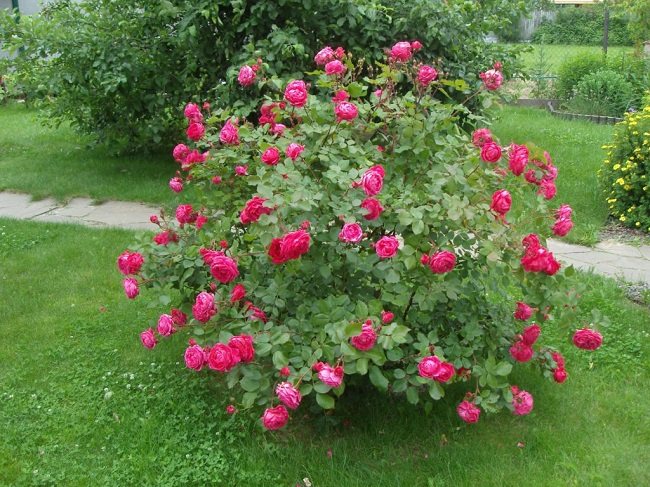

Casey park roses
Of course, if the roses are cared for, there may be other representatives of the pink kingdom in the collection: Floribunda, tea hybrids and strabas.
When the space for the rose garden is large enough, it is not necessary to fill it only with varieties with long flowering.There is a unique opportunity to find plants with spectacular flowers that bloom once. At the end of their flowering, the color of the flower garden is compensated by roses with long flowering periods.
Roses for giving:
- Perennial blue. A climbing rose that throws buds all summer long. The flowers are pink with a light blue, semi-double, collected in huge bouquets of 10-15 pieces;
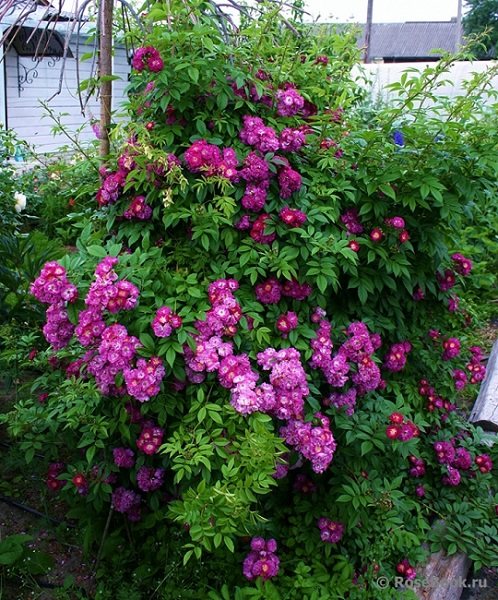

- Corvest. The orange flowers of this climbing rose are collected in several pieces, they smell nice;
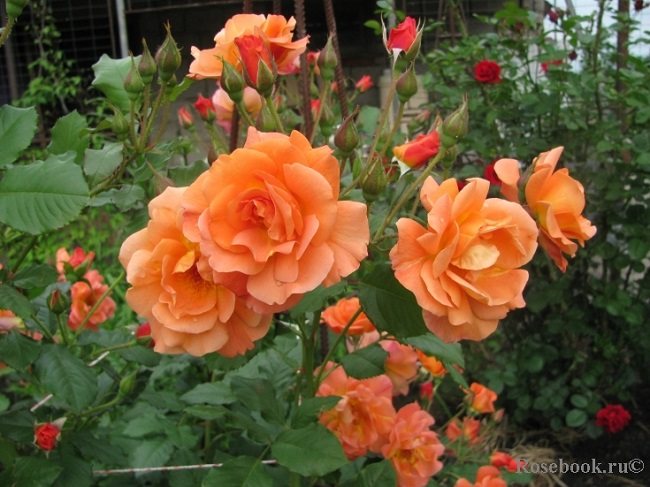

- Westerland. Park rose about 2 m high with expressive shiny leaves. Semi-double flowers of mixed color (yellow, golden, orange) have a strong aroma;
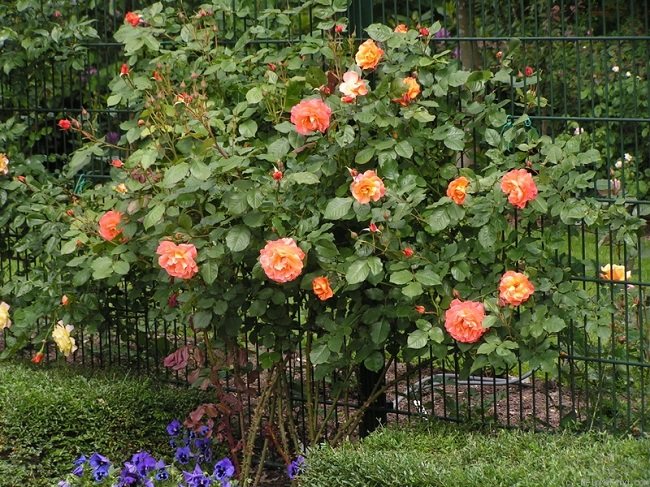

- Angelica. One of the hybrid tea roses with dark red flowers. The petals are gracefully bent outward. The height of the bush is about 95 cm;
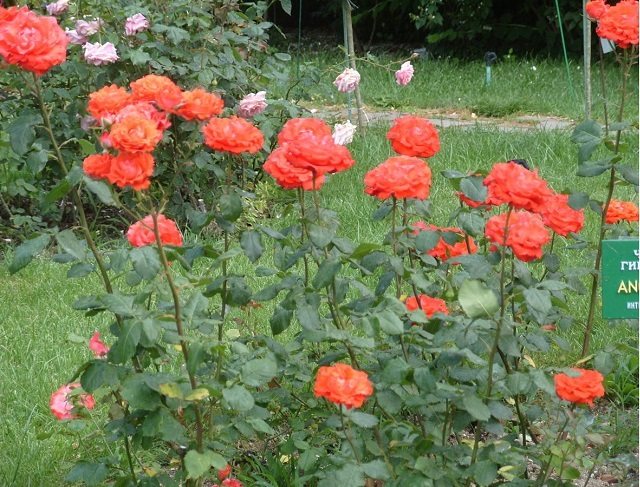

- New is old. Floribunda bicolor rose (pink with cream or red with cream). It blooms repeatedly, the height of the bush is up to 90 cm;
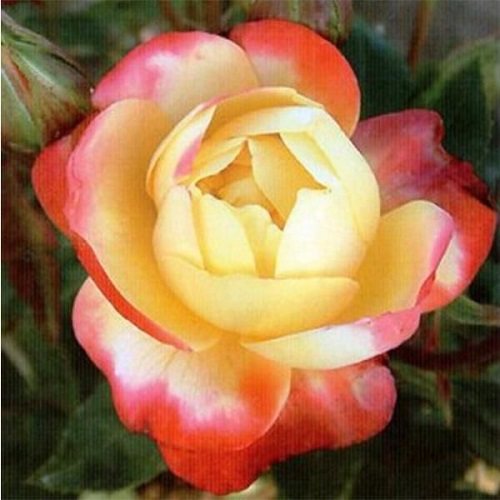

- Scarlet. Small-flowered (patio) scarlet;
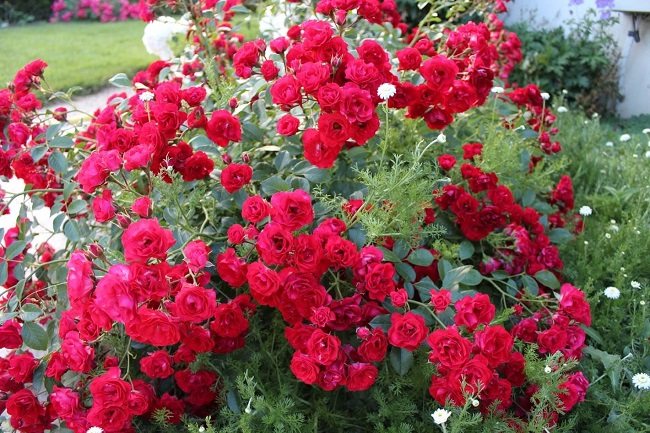

- Pat de velor. A variety of ground cover roses. Forms a picturesque carpet covered with small (4 cm) flowers of light pink color with a crimson edge;
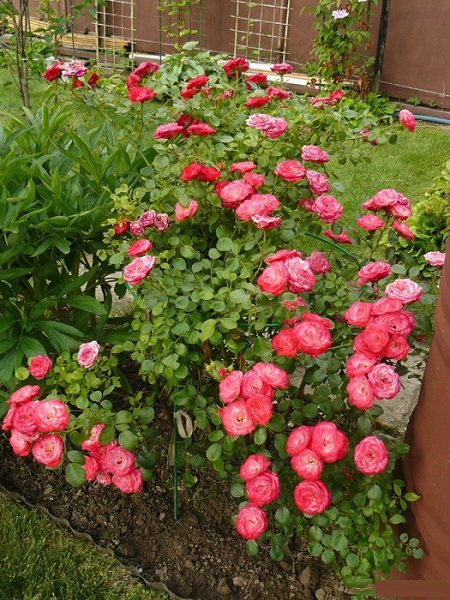

- Fontaine. Strab with large, velvety red flowers. The height of the bush will reach 2 m.
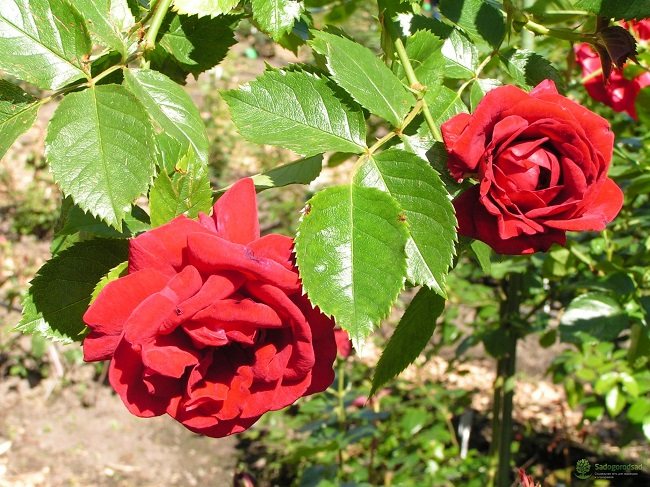

Overview of the rose garden with a description of the varieties:
Options for decorating the site with roses
Due to the variety of types of roses, it can be used in completely different landscape compositions. Braiding varieties are great for vertical plantings and hedges. Border hybrids will look good in the same type of flower beds. Floribunda and Grandiflora roses are suitable for solo compositions.
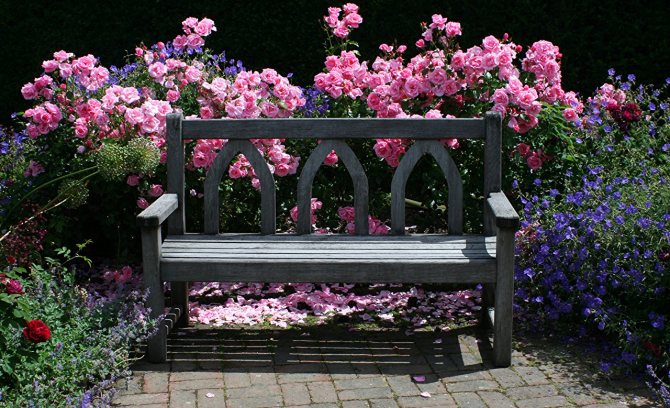

Bushy, tall hybrids will organically fit into the mixborder composition. A flower bed consisting only of the queen of flowers is called a rose garden. They are divided into types:
- Ceremonial. Includes varieties with a contrasting color.
- Vertical. They use a frame in the form of a gazebo or pergola for climbing varieties.
- Romantic. They land near recreation areas: patios, gazebos, terraces.
- Visible on the one hand. Suitable for decorating the inside of a fence or near a building wall.
- Visible from both sides. Ideal for lawns and central garden areas.
- Mobile. Roses are planted in portable pots and, if necessary, they can easily change their home to a new one.
- Rock gardens. Low-growing varieties decorate compositions of boulders and stones.
We will talk further about what kind of garden beauty can be created from roses and how to do it correctly.
Vertical rose garden
To create a vertical rose garden, you need a frame. The roof of a building or artificial supports with transverse beams can act in its role. Climbing roses are planted with a slight offset from each other, since a selfish plant will not tolerate competition even from relatives. Vertical rose gardens look good, in which royal bushes alternate with clematis. It is necessary to combine plants according to the color of the buds. If you need a contrasting flower garden, then white or blue clematis flowers will emphasize scarlet roses. To create similar, delicate compositions, combinations of pink and yellow buds are suitable.
Hedges and arches
With a hedge of roses, you can zone the site, cover up an unsightly fence, decorate the facade of a house, or fence off a place for privacy and relaxation. To create a royal "fence", bushy and weaving varieties are suitable. The latter will have to be equipped with well-camouflaged supports. Arches of roses will emphasize the transition from one zone of the site to another. They will symbolically outline the "entrance" to a special area: a garden, a place to relax, a secluded corner with a pond and benches. The arch can be bought ready-made or made yourself from thin slats and strong boards for supports. Only climbing varieties are suitable for decorating the frame.Such passages look good in hedges or in tapeworms. Roses are planted in autumn or spring. The first option is suitable for varieties grafted in a specific region. In the spring, the brought seedlings are dug in. The summer period will be enough for them to adapt to the peculiarities of the climate in gentle conditions. For hedges, varieties of roses from the Rugosa group of hybrids are considered optimal.
Flower beds and ridges
Flowerbeds are regular-shaped flower beds with bumpers. They can be planted with roses of the same variety or combined compositions. There are many options for combination schemes. Rabatki are elongated flower beds that are usually planted along garden paths. Their minimum width is one and a half meters. Plants in them are planted in rows from one to three bushes. Rabat roses are usually combined with sage, petunias, godetia, daylilies and crocuses. When choosing a variety, attention is paid to its prickly. If the thorns of the rose cling to the legs of people passing along the path, the rabat itself should be slightly pushed back and transplanted. Low shrubs are considered optimal for flower beds of this type.
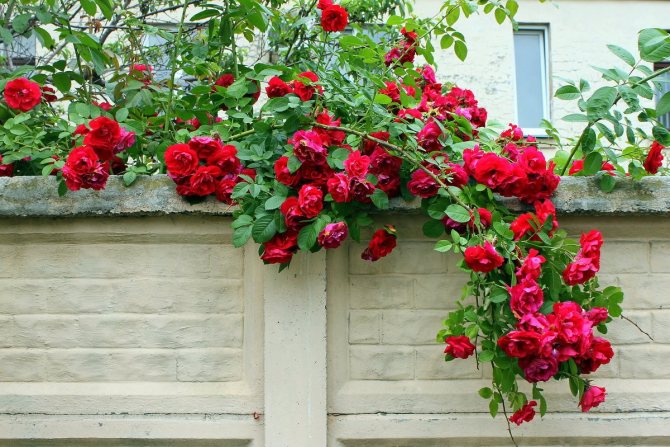

If the garden area is too small to fit the flower splendor in the form of flower beds, you can go for a little trick and plant standard roses. They are small trees, and not traditional bushes, the crowns of which are decorated with buds.
Curbs and parterres
Borders that follow the outlines of garden paths look nice and neat. Rose is a frequent visitor to this type of flower garden. Curbs are classified by height into three types:
- High.
- Average.
- Low.
To form the latter, miniature roses and patios are used. Floribundas and polyanthus varieties are suitable for tall ones. For medium curbs, shrubs of small height (40-60 cm) are chosen. Parterre is a flower garden in front of the facade of the house, the main "living" decoration of the exterior. It uses the most bizarre combinations of flower beds. Carpet flower beds of roses that form patterns or geometric shapes will look spectacular. Single bushes of tea hybrids in combination with small architectural forms are suitable for the English style in landscape design.
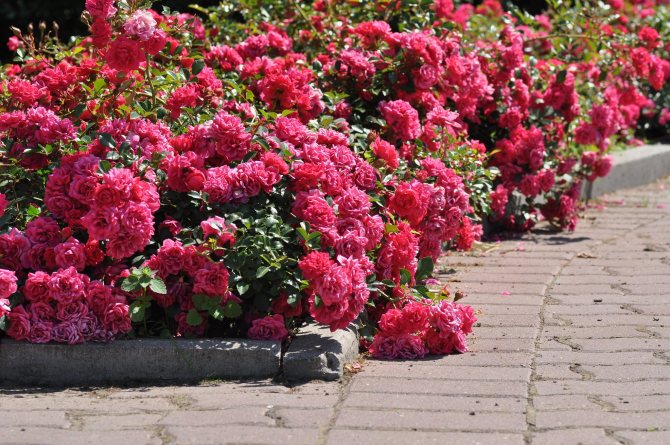

Plot decoration with Austin roses
Austin roses are considered the pinnacle of elegance among royal flowers. They are treated with special awe in England, where manor gardens are literally buried in these flowers. Austin's rose is universal, it can become part of a mixborder, grow solo in a separate place, be part of a flower bed or tapeworm. The bushes have a neat, spherical shape. When trimmed regularly, the rose does not grow upward and produces sprouts that almost weave along the ground.
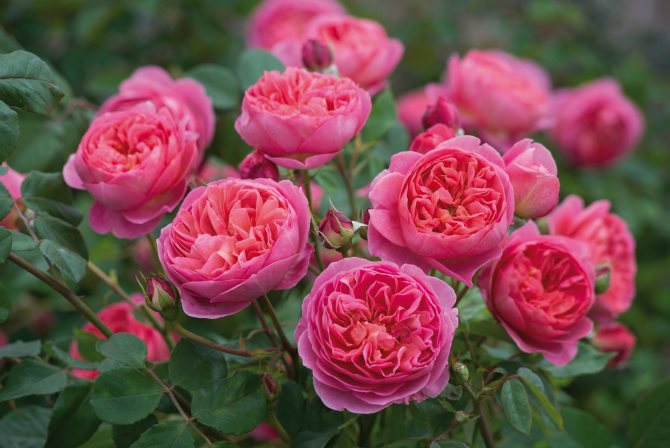

Solo rose
Solitary roses will definitely attract attention. For flower beds of this type, only majestic flowers are chosen, which can even in small quantities become the main decoration of the landscape. Salt roses are suitable for small areas where there is not enough space for large lawns. To make the bush look advantageous, it is advisable to plant it in an open area that is clearly visible. Miniature varieties and shrubs will do poorly in this role. For a solo composition, it is recommended to choose shrubs of medium height, which will rise above a flat lawn by at least 50-60 cm.
Mixborder - what to combine roses with
Mixborders are a flower potpourri that is squeezed into the frames of a flower garden. Only tea hybrids are hard to tolerate the neighborhood, so it is better to plant them in boles or salt. The rest of the groups of varieties can get along with other plants, if the latter are chosen correctly. For clarity, we will give a simple example. The rose is endowed by nature with longevity. Some rosehip bushes live for more than 5 centuries. The age of cultivated roses, of course, is not that impressive: only 25-30 years old with proper care.If the queen has "bad" neighbors with whom she cannot find a "common language", her life expectancy can be reduced to 5-10 years. It is recommended to plant crocuses, snowdrops, muscaria between the bushes in a mixborder. The last of the bulbous family will decorate the flower garden in the spring, while the roses will only gain strength. They are also combined with privet bushes, lilacs, acacia, sea buckthorn, hastas and conifers. Among evergreens, cotoneaster, magnolias and pyracantha are suitable. Good neighbors among conifers include thuja, spruce, and juniper.
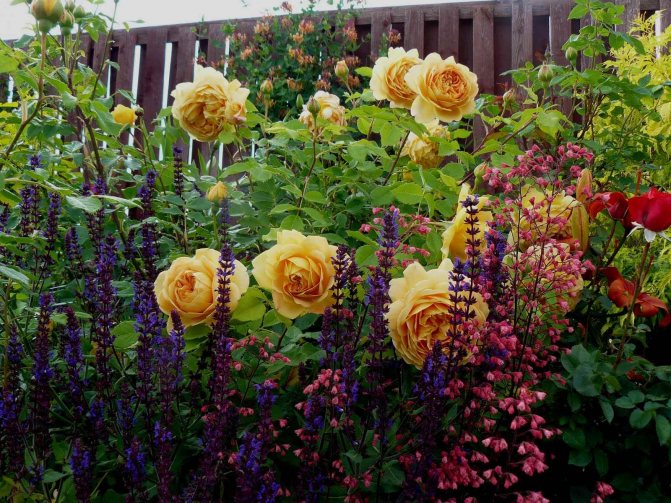

Roses and their "partners"
Roses are self-sufficient and do not need partners: compositions are easily created from them without using other plants. You can simply fill the empty space with a lawn, and its emerald greenery will be the perfect backdrop for a rose garden. If the flower garden is supplemented with other flowers, they should be introduced according to a pre-drawn plan.
Rose garden with onion
Daffodils, tulips, hazel grouses and muscari bloom during the period when rose bushes are just beginning to awaken after winter. The early flowering of bulbous plants brightens up the spring months in the rose garden, so their presence is very desirable. In early June, the wilting bulbous foliage is cut off so as not to spoil the landscape.
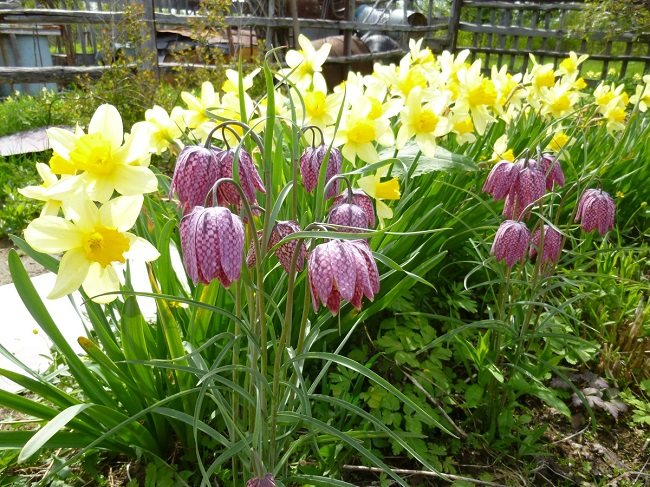

Daffodils and hazel grouses.
The same principle applies to lilies. They bloom later than daffodils with tulips, but somewhat earlier than roses. They can be placed in the central part of the flower bed so that the shoots of roses that have gone into growth hide the fading stems of lilies.
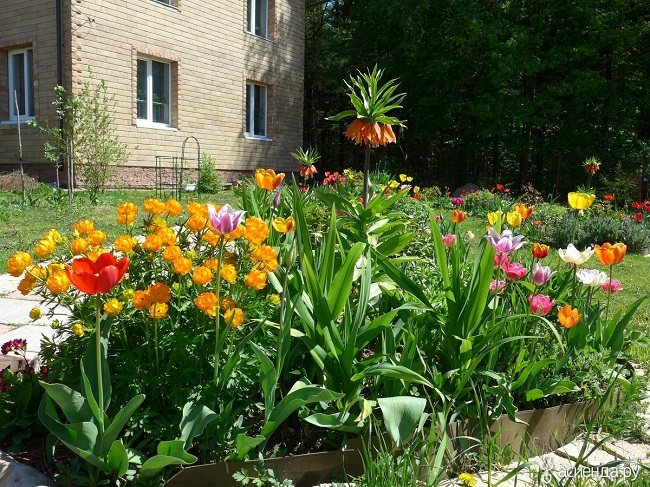

With hosts
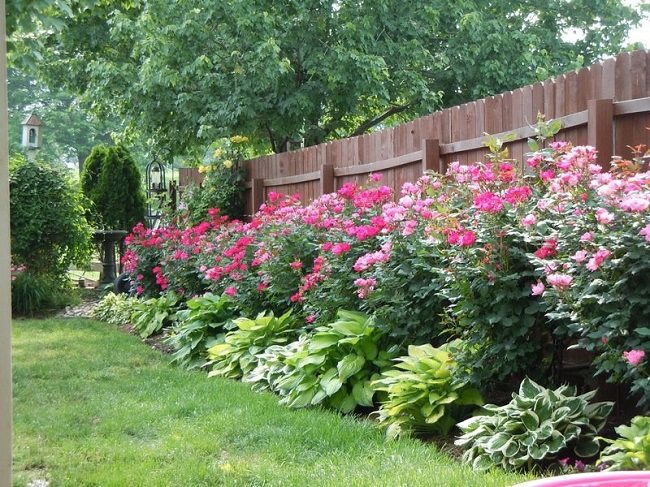

When you need to make a border along the rose garden, it is difficult to find a plant more suitable for this purpose than a host. Its wide foliage is collected in lush rosettes, and covers that part of the shoots on roses where inflorescences do not develop. A peculiar edging, reminiscent of a low green hedge, perfectly complements the planting of bush roses.
With annuals
If bright annuals are used in a flower garden with roses, it is recommended to choose colors to match the roses, but in calmer shades. The principle is that partners should not outperform the dominant plant in brightness. For example, marigolds can coexist next to roses of red and burgundy colors.
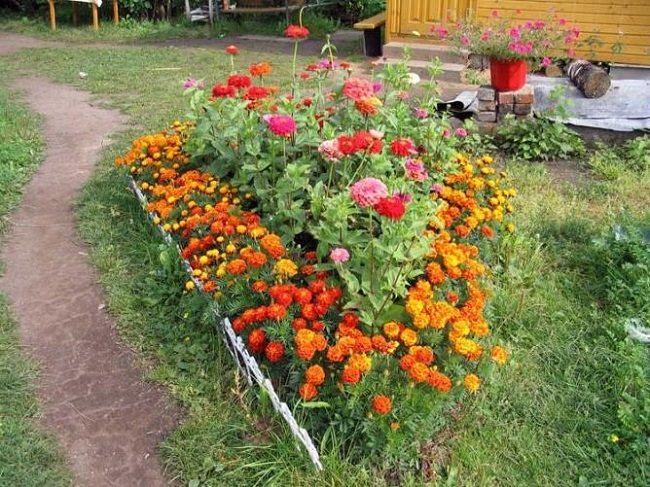

In habit, they are much lower than rose bushes, and are quite suitable for the role of a partner. Instead of marigolds, you can use nasturtium, gailardia, cosmea.
Veronica, gypsophila, lobularia, lavatera, petunia or ageratum are planted with roses of light, warm colors.
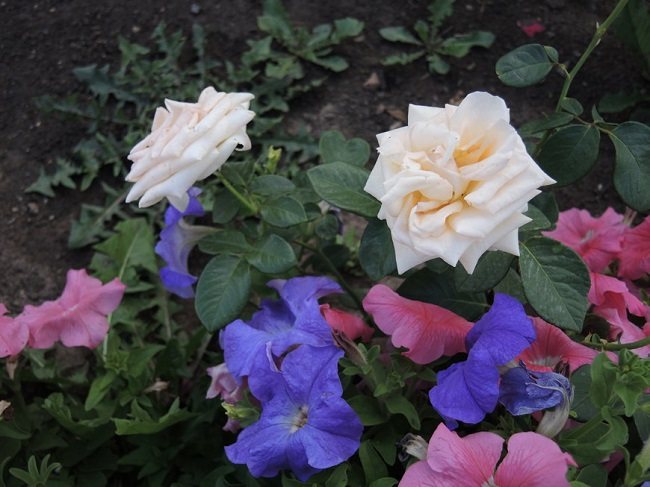

Rose with petunia.
Tips & Tricks
Shrub rose: planting and care in the open field
Having dealt with roses for many years, every gardener gains experience. A novice florist cannot know everything about roses, he often makes mistakes. He will be helped by the advice and observations of experienced rose garden lovers:
- The roses are very responsive to the selenium-containing banana peel. It is finely chopped and added dropwise in the surface zone. One peel is enough for each bush.
- Skeletal branches that need to be pruned are never cut in half. Only a third or two thirds.
- Once flowering varieties form a lush bloom on last year's growth. They are cut off immediately after flowering, so that the growth has time to form by winter.
Working in a garden with rose bushes is not hard, and besides, a person has a rest in his soul. And roses will thank with their flowering for every minute spent with them.
How to choose healthy seedlings
Seedlings with an open root system should be purchased immediately before planting, since during storage the root system dries out quickly, which affects the survival rate of the planting material. The bush must have at least 3 stems, a developed root system, as well as a root collar with a diameter of 1 cm or more.


You should not buy seedlings with sagging leaves and roots - this is a sign that the planting material has been on sale for more than one day (or maybe more than one week).
Saplings with a root ball or clay mash are protected from drying out, but they should also not be purchased long before planting. You can store them for about a week by wrapping an earthen ball in a damp cloth and spraying it with water from time to time. A closed root system does not always guarantee quality, so you need to pay attention to the condition of the leaves and shoots.
Roses in containers are usually sold in a blooming state, making it easy to determine the size of the flower, its color and even its aroma. They can be purchased in advance and kept in diffused shade until planting.
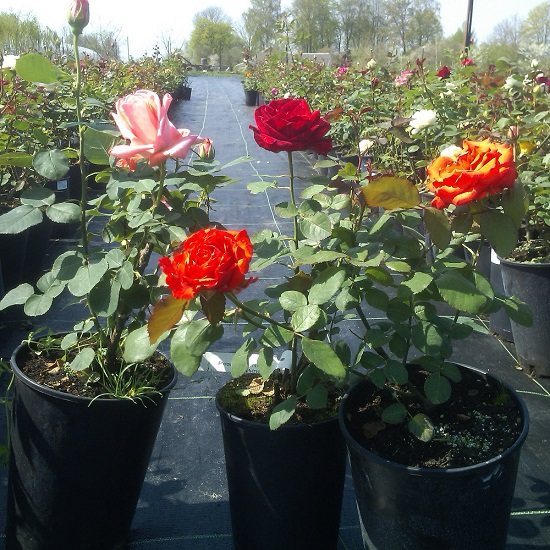

Important. When inspecting a seedling, you should inspect the leaves and stems. They should not show signs of fungal diseases (whitish bloom), dark spots and deformation of the shoots.
Watering beauties
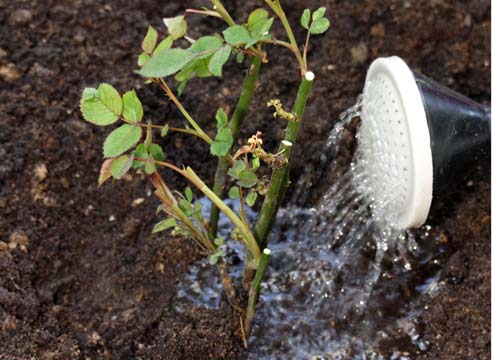

The rosette is an extremely moisture-loving plant, but irrigation care for roses depends on the phase of plant development. She needs the most abundant watering during the growing season (when the buds are stretched out, the growth of leaves and shoots begins and the first blooming of flowers).
At this time, the plant especially needs nutrients. And without water, fertilizers will not be assimilated, if there is little moisture - all fertilizing will be ineffective.
- For irrigation, use settled water, heated in natural conditions. Cold water from a hose or well will not work - the roses can get sick from cool watering. Water your beauties once a week (twice in hot weather). Water consumption 5-10 liters (for soil), 10-15 liters (for climbing) per bush.
Loosen the soil well after watering. Otherwise, a dense crust will appear on the ground. She will not allow the roots of our roses to breathe.
But you can get rid of constant loosening by mulching (leaf humus, chopped straw, rotted manure, tree bark or peat are ideal for mulch).
Autumn watering of roses. At this time, roses have less need for water. If the autumn is rainy, we stop watering in September.
In warm, dry weather, water the roses once a week, but reduce the volume of water by 3-5 liters.
A very important stage is pre-winter watering. Before the onset of cold weather, we need to water the roses very abundantly - at the rate of at least 30 liters for each bush.
Landing
The most favorable time for planting is October: during this period of autumn, plants root better, due to which they bloom earlier next year. Considering that the planting pits are prepared 2-3 months before the expected planting of seedlings, preparatory work should be done from the end of July - beginning of August. First of all, the type of soil on the site is analyzed, and then, depending on the results, it is prepared.
How to prepare the soil for planting roses in the fall
Most suitable for growing roses are light loams with a pH of 5-6. If the soil is sandy, humus is introduced into it, and if clay, then humus and sand are introduced into it. First, the territory is cleared of weeds, humus (or humus with sand) is distributed over the surface, and deep digging is carried out.
If August turned out to be dry, the site is well spilled with water. It is advisable to apply the sprinkling method so that the earth is saturated with moisture evenly and does not become overly compacted, as is the case with hose irrigation.
Hole preparation
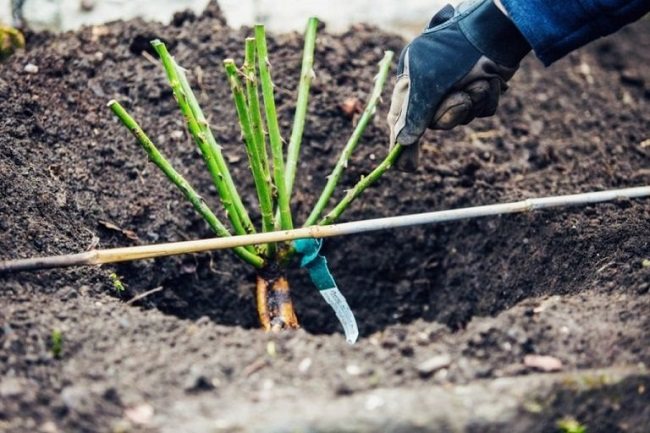

After 1-1.5 months, when the soil settles, planting holes are prepared. It is not necessary to make holes that are too large, it is enough to dig them 40 cm deep and 40 cm wide. If the soil is dense, it is recommended to make holes 15 cm deeper than usual, and pour a layer of drainage material on the bottom.
At what distance to make holes:
- Miniature types of roses - 30 cm;
- Patio roses - 50 cm;
- Hybrid tea - depending on the variety from 50 to 100 cm;
- Stamp and shrub - up to 2 m;
- Climbing - from 2 to 3 m;
- Groundcover - the distance depends to a large extent on the formation of the bush, on average it is 2 m.
When preparing holes, you do not need to be guided by the size of the planting material, since they do not reflect the habit of an adult plant. Too thickened plantings are dangerous for the development of diseases. In addition, remaining constantly in the shade, the lower part of the bush loses its leaves, which affects the decorative effect of the flower garden.
A rare planting is also not desirable, since the space between the bushes begins to overgrow with weeds, and the earth overheats in the open sun.
Seedling preparation and planting
On the seedlings, 2-3 of the strongest stems are left, and the rest are cut to the base. Those that remain are greatly shortened: no more than 3 lower buds should be left. The roots on planting material with an open root system are cut to a length of 20-30 cm.
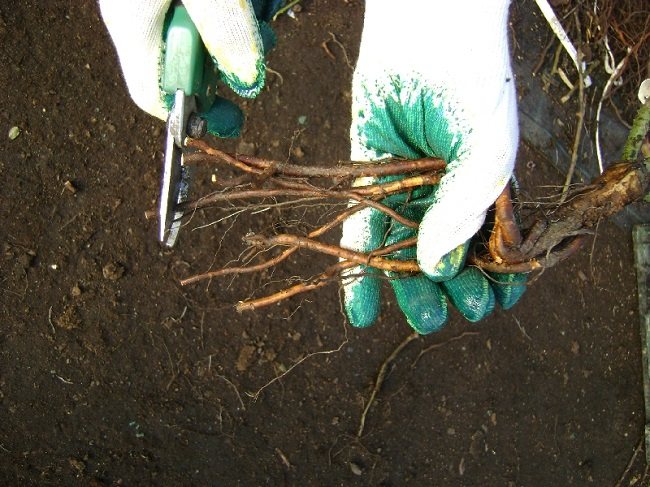

This procedure is mandatory, as it contributes to the faster growth of new roots.
A small earthen mound is poured under plants with open roots, roots are evenly distributed along its slopes, and sprinkled with soil mixture from garden soil and humus. After watering, the soil is poured.
Planting a rose from a pot
How to plant roses from a pot? In nurseries or gardening shops, in addition to rose roots, you can purchase small bushes that grow in pots. Planting them is similar to working with roots. Dig a hole first. Its depth and diameter will depend on the size of the container, plus additional space to accommodate nutrients. Once you've dug the holes, add about 4-5 cm of organic compost, manure, or peat moss to the bottom of the hole.
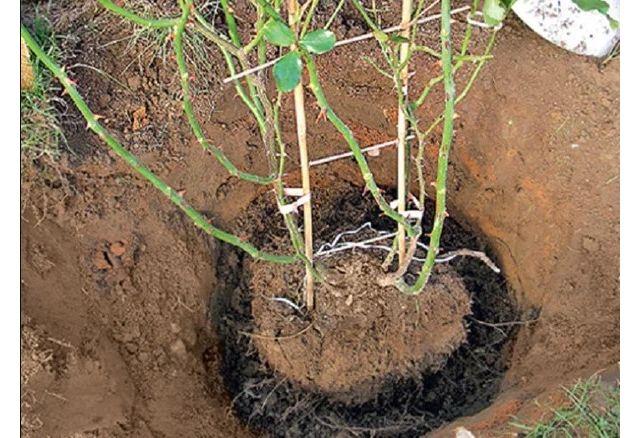

Remove the rose root club from the pot without shaking off the soil, and place in the prepared hole to such a depth that the green parts of the plant (stems and leaves) are not dug in. Sprinkle everything with previously dug soil, add some compost on top and water liberally.
Rose garden care
Pleasure can be brought not only by the contemplation of beautiful rose bushes, but also by the systematic care of them. Although roses are very diverse, the rules of care and cultivation are the same for them.
Watering
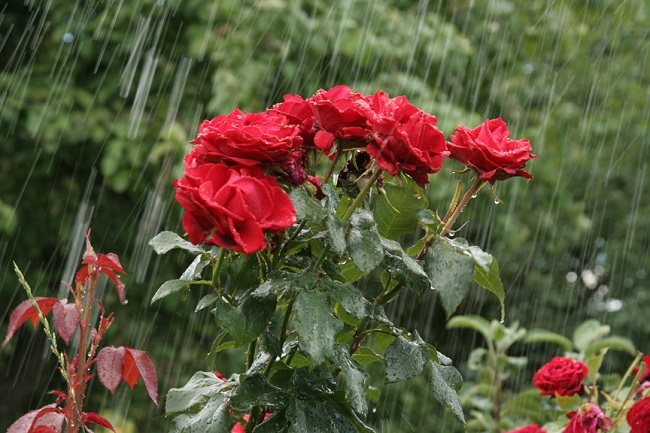

Watering the rose garden should be done in moderation. Roses are not capricious, but they do not like too wet ground. The soil should also not be allowed to dry out: plants will quickly respond to a lack of moisture by reducing bud formation, and a weak growth of shoots.
The irrigation regime is regulated depending on the weather conditions of the current summer. If there is not enough rain in the morning, sprinklers are turned on and, in addition, 2 times a week, abundant watering is carried out under each bush. In a rainy summer, there is no need to fill the flower garden with water.
Pruning
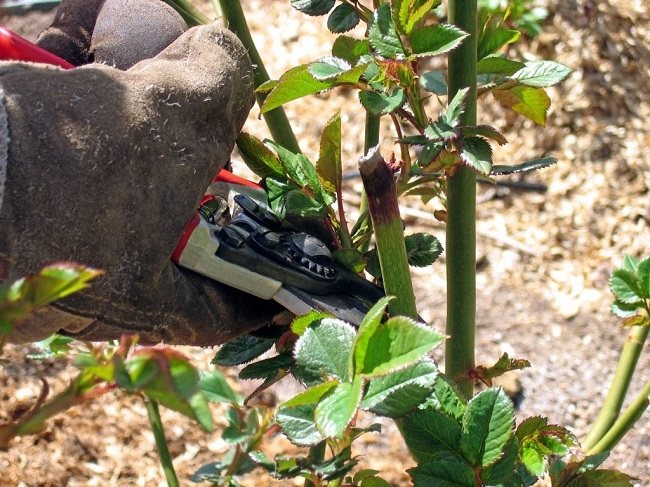

Roses are pruned most of the time in the spring. But it is not correct to cut all plants "one size fits all", there are peculiarities of pruning each type of roses.
- Hybrid tea. In the spring, all stems are shortened to 2-3 lower buds, weak and thin ones are cut out completely. In late May and early summer, long shoots are pinched to stimulate branching;
- Climbing. Only weak and old shoots are cut out, last year's ones are left, as buds are laid on them. Every 7-10 years, a rejuvenating haircut is carried out, in which all the lashes are cut off at a height of 50 cm from the ground.
- Floribunda. Young shoots are shortened by 1/3 of the length, and 2-year-olds at a height of 2-3 buds from the ground;
- Park. Sanitary and rejuvenating pruning is carried out: old and weak branches are cut out to the root collar.


Pruning is carried out in dry, sunny weather, when there is no danger of infection with fungal diseases. Slices are made over the outer bud towards the inside of the bush.
Preparing for winter
A special point of care for the rose garden is its preparation for winter. Not all roses need shelter. Old varieties and species (not counting English roses) can be left as is.By the end of summer, their vegetative growth stops, a sufficient amount of carbohydrates accumulates in the wood, the bark coarsens, and by October the plants are ready to face frosts.
Modern remontant varieties of roses bloom before cold weather, so their shoots do not have time to mature enough for wintering. There are 5 ways to speed up the process of lignification of shoots. They can be applied to all types of roses, those that need shelter and those that do not need shelter.
How to prepare roses for winter:
- From the beginning of September, earthworks in the rose garden cease: digging, loosening, weeding. This step will reduce the likelihood of the resting kidneys waking up;
- Since August, phosphorus fertilizers are added under the bushes, which will accelerate the process of wood ripening;
- Before the onset of autumn, several wilting flowers are left on the lashes to stop bud formation;
- The tops of the shoots are pinched (especially with a reddish tint of the leaves);
- At the end of October, shoots on floribunda, polyanthus and hybrid tea roses are cut to 1/3 of their length. Small-flowered pinched;
Roses take refuge almost before the very frosts, around the end of October, in November. The most suitable for shelter are materials of natural origin: spruce branches, leaves, coniferous sawdust and, of course, snow. At first, the bushes can be covered with a spanboard (or other type of agrofibre), and then filled up with what is available. After the first heavy snowfall, the plants are additionally covered with snow.
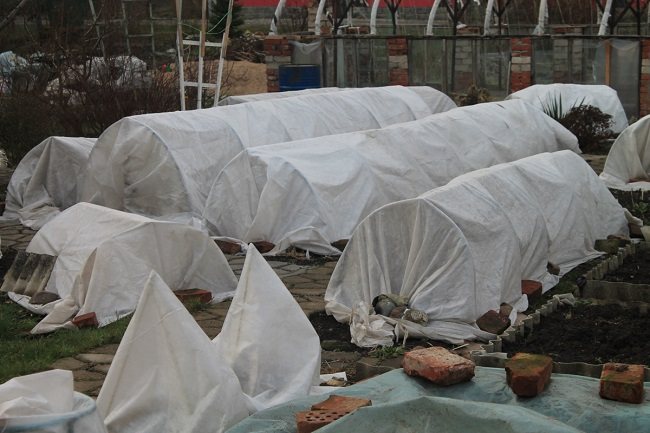

Advice. If roses hibernate without shelter, they should still be protected from frost. In October, the lower part of the bush is covered with loose soil, humus or forest floor. The height of the mound is 20-30 cm.
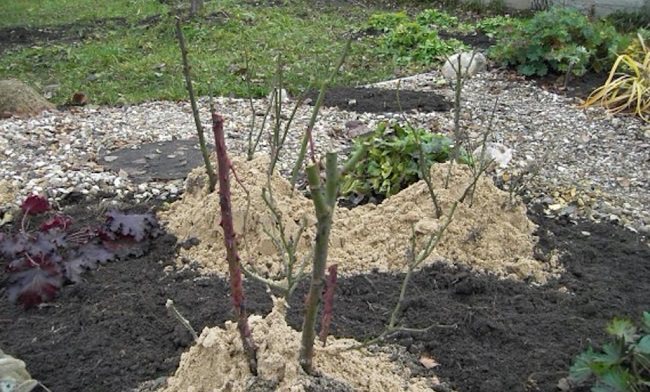

Pruning roses by seasons
When planting flowers, novice gardeners know that roses are pruned at any time of the year, except for winter.
However, the goals of seasonal pruning are different:
- in spring it is produced to renew bushes, stimulate growth and abundant summer bloom;
- in the fall - this is pruning roses for the winter and preparing them for wintering: wrapping; in summer it consists in removing fallen buds.
Pruning roses in spring
Spring pruning of roses is a very important step in the care. Wrong movement can harm an entire rose bush and it will die.
- Dried leaves, damaged twigs and dead shoots are removed - they become brown during the winter;
- Weak and diseased branches need to be cut to provide healthy lighting and air, in addition, this will help to avoid contamination of the entire bush with a fungus;
- after an examination is carried out, during which three sprouts with swollen buds are selected;
- the selected branches must be cut obliquely to the buds;
- further remove the shoots facing the growth inside the rose bush;
- a beautiful crown with a small center is formed;
- treatment with copper sulfate is carried out (100 grams per bucket of warm water), the bush is carefully sprayed.
Roses must be covered with foil even after pruning, if a cold snap is possible in the future. It is not uncommon for the climate when, on the May holidays, after a series of warm days, frosts or even snow fall.
When pruning, you should take into account many factors that can further affect the bush:
- climate - less pruning in cooler climates;
- landing place on the sunny side;
- type and growth of the plant.
Pruning roses in autumn
In the fall, roses are pruned in mid-October. This is a very important point: in no case should you start pruning before the first frosts begin. Pruning gives a kind of start for the growth of buds, so if you cut the roses before a possible warming, which often happens, then the bush will grow. Before winter, you need to be careful and immediately treat the pruning site with an antifungal drug. For example, you can use at least simple charcoal from the barbecue.


